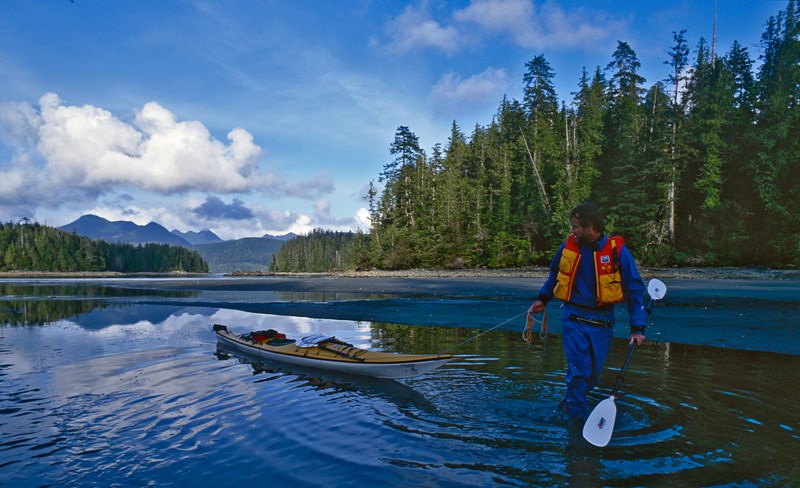“Probably not for everybody, but there was something perversely interesting and challenging about it.”
That's how wilderness explorer John Dunn cheerfully described the second leg of "Journey North," an 8,000-kilometre, 400-day trek from the southern border of Canada to its northernmost tip on Ellesmere Island, during a visual presentation at the Pemberton & District Public Library on Feb. 3.
Dunn grew up in the United Kingdom, but was always enamoured with North America’s wilderness, as evidenced by a poster map of Baffin Island that adorned his university dorm room.
“How do you go from England to being in love with the wilderness of North America?" asked Dunn. "Maybe because in England, there wasn’t any wilderness.”
He remembers the adventure that inspired his love of Canada—a boat trip with his brother up the west coast of Greenland. At the end of the trip, he could see Ellesmere only about 40 km away.
“That view inspired me to start doing some human-powered journeys,” recalled Dunn. “So I ditched the powered form of travel and started doing human-powered stuff like skiing on Ellesmere Island.”
He once joked to a Swiss crowd that a subsequent trip on Baffin Island, which took 193 days, was roughly equivalent to walking across Switzerland. In fact, Baffin itself is more than 10 times bigger than Switzerland.
“That put it in some sort of scale, because of the size of the place we live in," said Dunn. "It kind of wiped the slate clean and made me think about what to do next.”
He settled on an actual country trek—not across Switzerland, but across Canada.
Tofino to Ellesmere
Dunn kicked things off in Tofino—situated roughly on the 49th parallel that divides Canada from the U.S.—and started kayaking north.
“Should I have been paddling up the outside of Vancouver Island on my own in April with not a huge amount of kayaking experience? Probably not,” he said with a smile.
“But kayaking seemed to be somehow appropriate because you’re going to be finishing up hopefully in the land of the Inuit, who invented the kayak.”
Dunn’s presentation flashes to a picture of him taken from the bow of his kayak. He's aware of how strange some of the angles must seem to the audience; the trip, having started in 1997, took place before the development of the photo technology seemingly required to take some of the shots he shares.
Some photos required extraordinary creativity, like a tracking video of Dunn kayaking, taken from several metres away. He’d placed his camera on a chunk of ice floating downriver with him. Other pictures required patience and commitment, like sprawling landscape shots where he and his companion were reduced to specks in the distance. Every picture has an elaborate story behind it.
At several points during the journey, he lost his tent. And while one particular incident left him chasing after it—in “a sort of Monty Python-esque chase” across the Arctic—another left him and his then-travelling partner, biologist Bob Saunders, with nothing but a tarp to protect them from the elements.
What Saunders hadn’t lost, Dunn recalls, was a perfectly clean pair of blue jeans to throw on once they reached Fort Nelson—a pair of pants he’d been hauling for 54 days. After pulling into Nelson at the end of the second leg of the journey through the cordillera, Dunn decided to press pause on the journey.
He returned to the adventure 16 years later.
In the decade and a half he’d waited to resume his journey, equipment evolved. The boats were much lighter, and Dunn obtained a sled with massive, resilient wheels, to the crowd’s delight.
The view from the very top of Canada, a place called Cape Columbia, reveals a frozen sea of massive ice boulders. Nearly 800 kilometres lie between the Cape and the North Pole. It would have been nearly un-passable for Dunn and his crew, and marked the end of the road for the expedition.
“The people who used to go to the North Pole, I kind of admire them, but I think they’re absolutely lunatic at the same time,” Dunn told the assembled villagers.
Dunn originally budgeted for three years to do the entire trip. And while it would take 10 separate expeditions and about 20 years to finish the trek, he (mostly) accomplished his goal.
The wildlife along the way
Dunn’s presentation is replete with stunning pictures of Canadian wildlife, both up close and from a distance.
He says travelling down the river was a great way to see animals—including deer, some moose, and a bear gorging on what Dunn speculates was “a very ripe moose.”
“Make sure you always have the camera ready, because you never know who or what you might see,” Dunn told his audience. “The spruce grass is nothing too special, but the wolverines zipping past... they don't wait for anybody.”
He also came across the remnants of great Arctic beasts. One particularly lucky find: a perfectly preserved narwhal tusk. Despite being told it could net him and Saunders between $5,000 and $10,000, Dunn said he decided to turn it over to the community in Resolute Bay.
A collective “awwww” went up from the crowd during a short video of “a very curious native lemming only about, literally ... the size of a golf ball.”
“That is a wonderfully wild landscape up there,” said Dunn. “And just oozing with history.”
A call to action
Dunn told the audience Canada offers a unique opportunity for trailblazing expeditions.
"If you wanted to do a journey on northern Ellesmere Island, well, there's maybe thousands of peaks there that have never had a human footprint on them outside of the National Park," said Dunn.
He hopes someone takes a trip from further south in Canada, the southeastern tip of Ontario, to Ellesmere. A group of adventurers completed the trip in reverse, partly by cycling, in 2021. Dunn challenged the audience to do it without the cycling portion; a true human-powered trip across the expanse of Canada.
Regardless of the route, he just wants people to get out and enjoy an adventure.
“When I talk about this in schools, I lay down the challenge for the kids and say, 'well, that's my journey,'" he said. "'Now, what might your journey be?'"




